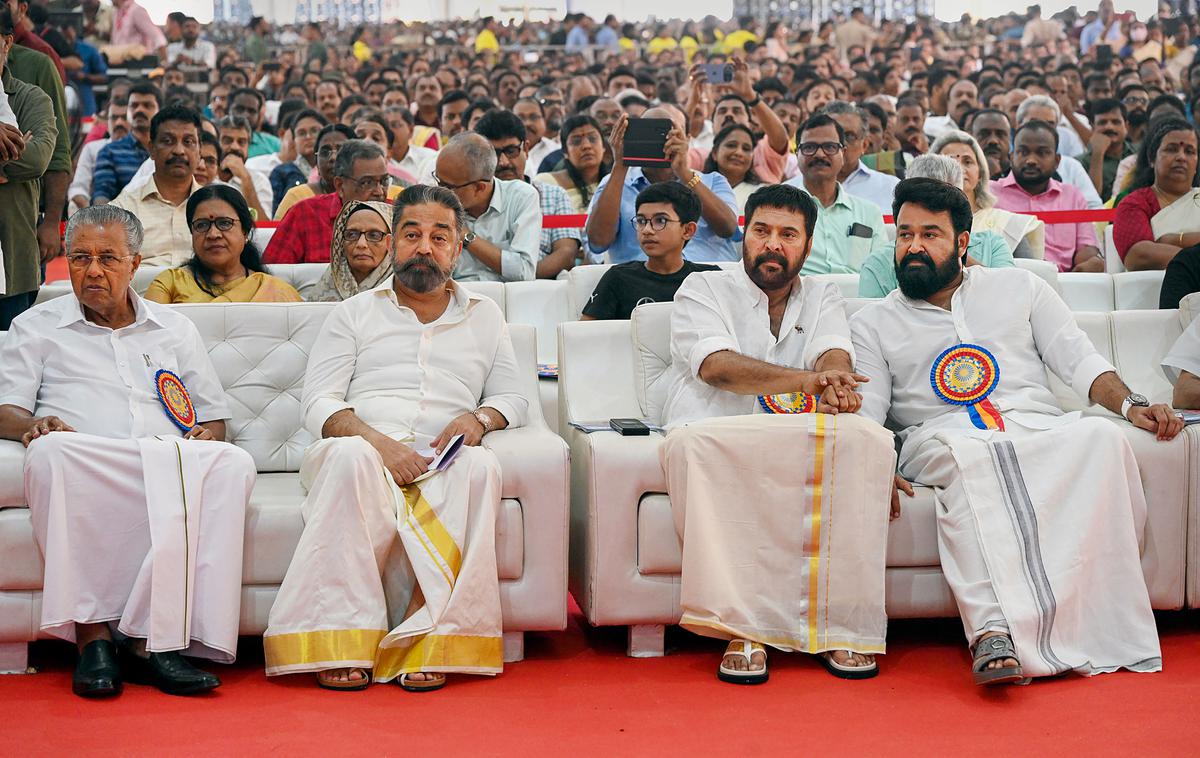The state is now finding it impossible to manage even everyday expenses, and the possibility of fresh borrowing remains nil.

Chief Minister Pinarayi Vijayan. actors Kamal Hasan, Mammootty and Mohanlal at the inaugural of Keraleeyam. (Supplied)
When the Kolkata-based spiritual organisation Sri Ramakrishna Mission deposited ₹130 crore as a fixed investment in the Kerala government-owned non-banking finance company Kerala Transport Development Finance Corporation (KTDFC) years ago, the guarantee was that if it failed to repay the amount, the government would step in and cover the deposit.
The investment is now past its maturity date, and the Mission wants its money back with interest. However, things are not turning out as it had anticipated.
The KTDFC has told the Mission — and several other depositors — that it would be unable to settle outstanding term deposits.
This is mostly due to the Kerala State Road Transport Corporation’s (KSRTC) failure to repay loans and the Reserve Bank of India (RBI) restraining the KTDFC from accepting fresh deposits.
The KTDFC’s total outstanding loans, including interest, were at ₹912 crore, according to the most recent information. As a result, the cash-strapped state government is currently struggling to honour its obligation to the company’s term depositors.
One of the KTDFC’s major depositors petitioned the Kerala High Court, asking it to intervene and direct the state government to return the deposit.

The logo of Keraleeyam designed by noted artist Bose Krishnamachari. (Supplied)
The LDF government, led by Pinarayi Vijayan, told the court earlier this week that Kerala was in the throes of an unprecedented, huge financial crisis and lacked the capacity to fulfil such promises.
The government also informed the court that it has permitted KTDFC and KSRTC to repay the money through the sale of land or by pledging immovable assets, including major bus terminal buildings.
This outright acknowledgement of a financial crisis came even as the state government was spending crores from the public purse on Keraleeyam, a weeklong festival from 1 November, commemorating the state’s Formation Day.
The dance and drama festival was meant to showcase, among other things, the state’s many “achievements” in a month that marks the halfway point of the Vijayan government’s mandate.
Instead, coming as it does as the Kerala government confessed its financial troubles in open court, it has only drawn attention to the rot within.
It is no wonder that the Opposition, the Congress-led United Democratic Front (UDF), is boycotting the ongoing festivities, saying they reeked of “arrogance and luxury”.
”When the second Vijayan government came to power, it announced a massive house-building programme for the homeless, dubbed Life Mission, with an annual budgeted allocation of ₹717 crore. However, due to financial constraints, the government has only committed ₹17 crore to the mission thus far in the current fiscal year,” Leader of Opposition in the state Assembly VD Satheesan told South First.
“Due to a lack of funds, the state’s midday meal programme in schools is in jeopardy, and teachers are being forced to spend money from their own pockets to buy supplies. Welfare pensions are pending for the last four months,” he pointed out.
Take the case of KSRTC itself. The government informed the high court that it has spent ₹8,440.02 crore on KSRTC alone since the first Vijayan government took power.
Yet, the corporation’s accumulated losses have expanded dramatically and, today, employees receive their monthly salary in four instalments.
On 2 November, the administration raised the power tariff in the state and informed the public that the increase would be an annual event from now on.
“The government is neck deep in crisis, but it spends ₹27 crore on an extravaganza that can provide no relief to the suffering masses,” Satheesan added.
According to economist Mary George, the state has repeatedly failed to handle its increasing public obligations, and the current financial crisis will have far-reaching economic effects, particularly on the poorest of the poor.
She has urged urgent measures to close the widening debt gap and has warned that if the situation does not improve, the state will have to borrow more money to meet its current obligations.
To make matters worse, the state’s borrowing options are exceedingly limited.
The state’s public debt has increased from ₹25,721 crore in 2000-01 to a massive ₹3.57 lakh crore, according to figures from Thiruvananthapuram-based Gulati Institute of Finance and Taxation.
In a recent report, the institute urged the state government to reduce public debt to less than 27.8 percent of the GSDP by implementing austerity measures such as reducing social welfare activities and extravaganzas.
It also suggested that the state borrow more money at reduced interest rates and seek additional help from the Union government.
This last looks difficult, given the current relationship between the CPI(M)-led LDF in the state and the BJP-led Union government.

Ace footballer I M Vijayan with students at a promotional programme of Keraleeyam. Photo: supplied.
According to economist Jose Sebastian, Kerala competes with Scandinavian countries in welfare schemes but is on par with African countries when it comes to taxation and financial management.
Kerala’s debt is by far the most concerning in the country, according to the RBI.
All of this is taking place at a time when the state’s tax revenue has surged by an incredible 18.5 percent.
The ratio of state tax revenue to total tax revenue has already reached 85.5 percent, placing the state third in this category.
At the same time, the proportion of financial aid from the Union government has been reduced from 25.8 percent to 20 percent.
The spending on Keraleeyam celebrations in the state capital, according to Opposition leader Satheesan, is an example of an administration that does not know where its priorities lie when it comes to spending money.
It is against this background that the chief minister and his Cabinet has planned a massive outreach programme to each Assembly constituency in the state that also requires crores from the exchequer.
For one-and-a-half months, the state Cabinet would be completely absent from the secretariat in Thiruvananthapuram, while Vijayan runs the show from each Assembly constituency.
There are no scheduled holidays during the trip, which begins on 18 November and ends on 24 December, and it has been decided that the chief secretary would travel to the tour locations for Cabinet meetings every Wednesday.
The trip will function almost like election campaign rallies organised by political parties or fronts.
Each day, four constituencies would be visited, according to the plan. The team will meet with prominent individuals from those four constituencies in the morning at an important spot in the constituency.
Naturally, a significant amount of money would be spent on travel as well as related meetings and consultations.
Meanwhile, the government has yet to pay six DA and pension arrears instalments, even though over a lakh senior citizens have died without collecting their due pension payments.
Five hundred government school teachers have refused to be promoted because they are afraid that if they accept the promotion, they will have to pay for their students’ lunch from their pockets, at least for the time being.
The Kerala State Civil Supplies Corporation (Supplyco), according to the government, owes its suppliers approximately ₹1,500 crore.
Farmers have not been paid for paddy, which is still an issue in places like Alappuzha and Palakkad.
The government’s financial crisis is also reflected in the fact that local self-government bodies have failed to fund various improvement projects on schedule. Life Mission has suffered due to a lack of funds, and depositors of the scam-hit Karuvannur Cooperative Bank are yet to be compensated.

May 17, 2024

May 17, 2024

May 16, 2024

May 16, 2024

May 16, 2024

May 16, 2024